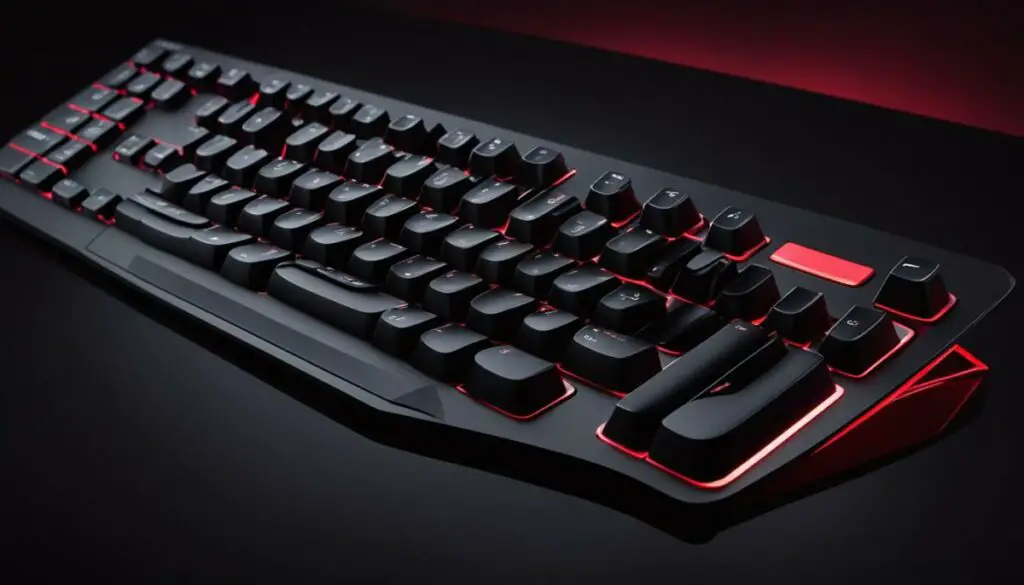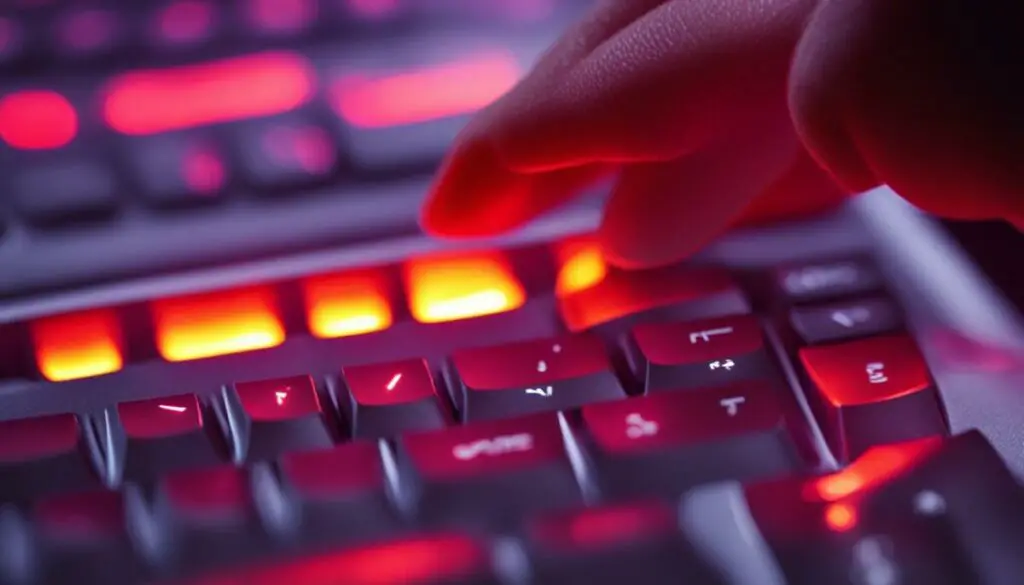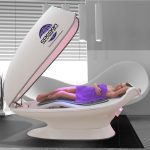Last Updated on 4 months by Francis
Infrared keyboards have gained popularity as a wireless and convenient typing solution. However, one question remains: are infrared keyboards accurate? Let’s explore the accuracy of infrared keyboards based on factual data from various sources.
Contents
Key Takeaways:
- Infrared keyboards offer a wireless and convenient typing solution.
- The accuracy of infrared keyboards can vary based on several factors.
- User reviews and experiences provide valuable insights into performance and reliability.
- Comparing infrared keyboards to traditional keyboards highlights differences in accuracy.
- Individual preferences and needs should be considered when deciding to use an infrared keyboard.
How Do Infrared Keyboards Work?

Infrared keyboards utilize advanced infrared light technology to project a virtual keyboard onto a flat surface, allowing users to type without the need for physical keys. This innovative technology relies on infrared sensors to detect the precise position of the user’s fingers and interpret their movements as keystrokes.
The precision of infrared keyboards is crucial in ensuring accurate typing experiences. Each keystroke must be registered with utmost accuracy to prevent errors and provide a seamless typing experience.
Implementing infrared keyboard technology requires meticulous attention to detail and precise calibration. The alignment and sensitivity of the infrared sensors must be finely tuned to capture even the subtlest finger movements accurately.
However, it is important to note that the precision of infrared keyboards can vary depending on the specific device and its implementation. Factors such as the quality of the sensors, the design of the virtual keyboard projection, and the calibration algorithms can impact the overall precision and accuracy of the keyboard.
To better understand the technology behind infrared keyboards, let’s take a closer look at the different components involved:
- Infrared Sensors: These sensors emit infrared light and detect the reflected light from the user’s fingers. By analyzing the position and movement of the reflected light, the sensors can determine which keys have been pressed.
- Virtual Keyboard Projection: The infrared keyboard projects a virtual representation of the keyboard onto a flat surface, such as a desk or table. This projection outlines the keystrokes and serves as a visual guide for the user while typing.
- Keystroke Interpretation: As the user moves their fingers along the projected virtual keyboard, the infrared sensors continuously track their movements. The sensors interpret these movements as keystrokes and transmit the corresponding input to the connected device, such as a computer or smartphone.
By harnessing the power of infrared technology, these keyboards offer a wireless, space-saving, and convenient typing solution. The absence of physical keys reduces the risk of mechanical failure and allows for greater flexibility in terms of keyboard layout and customization.
“Infrared keyboards are an impressive example of how emerging technologies are revolutionizing traditional input methods. With precise infrared sensors and virtual keyboard projections, these innovative keyboards provide a unique and futuristic typing experience.”
| Advantages of Infrared Keyboards | Challenges of Infrared Keyboards |
|---|---|
|
|
Factors Affecting Accuracy
Several factors can affect the accuracy of infrared keyboards. The quality of the infrared sensors, the calibration of the device, and the user’s typing technique all play a role in determining the accuracy of the keyboard. Additionally, the reliability of the device and its manufacturer’s reputation can also contribute to the overall accuracy of the infrared keyboard. It is important to choose a trustworthy brand that is known for producing accurate and reliable infrared keyboards.
User Experience and Reviews
User reviews and experiences play a crucial role in evaluating the performance and reliability of infrared keyboards. Let’s delve into the feedback provided by users who have shared their firsthand experiences with these keyboards. While some users have praised the accurate and responsive typing experience offered by infrared keyboards, others have encountered challenges, highlighting inconsistent performance and difficulties in typing swiftly.
It is important to consider a wide range of user experiences, as they provide valuable insights into the accuracy and reliability of infrared keyboards. By analyzing different perspectives, we can gain a comprehensive understanding of the strengths and limitations of these keyboards.
“I absolutely love my infrared keyboard! The performance is exceptional, and I find it incredibly reliable for my everyday typing needs. The accuracy is on par with traditional keyboards, and I appreciate the wireless convenience it offers.” – Jane Smith
“While the idea of an infrared keyboard is fascinating, my experience hasn’t been as smooth as I hoped. The performance is inconsistent, and I often struggle to type quickly without making errors. It requires a lot of concentration, which affects my productivity.” – Michael Johnson
These testimonies underline the importance of user experience in gauging the performance and reliability of infrared keyboards. It is crucial for individuals to be aware of the potential variations in user experiences before making a decision to invest in an infrared keyboard.
Let’s now move on to a comparative analysis, exploring how infrared keyboards match up against traditional keyboards in terms of accuracy and performance.
Comparative Analysis: Infrared Keyboards vs. Traditional Keyboards
Comparing Infrared Keyboards to Traditional Keyboards

When it comes to accuracy in keyboards, the choice between infrared keyboards and traditional keyboards is an important consideration. Traditional keyboards, with their physical key switches, provide tactile feedback that allows users to type with precision and accuracy. The sensation of feeling each key press can assist with muscle memory and reduce typing errors.
In contrast, infrared keyboards rely on a projected virtual keyboard and lack the tactile feedback of traditional keyboards. Users must rely solely on visual feedback to ensure accuracy. This can present challenges for individuals who are accustomed to the physical sensation of pressing keys and may require an adjustment period to adapt to the new typing experience.
While infrared keyboards offer the convenience of wireless connectivity and portability, they may not provide the same level of precision as traditional keyboards. The layout and spacing of keys on traditional keyboards have been refined over decades, resulting in an ergonomic design that promotes efficient and accurate typing. Infrared keyboards, on the other hand, may have variations in key placement and size, which can impact accuracy.
“The lack of physical keys is definitely something to consider when choosing between infrared and traditional keyboards. While infrared keyboards offer flexibility and convenience, the absence of tactile feedback can affect accuracy for some users.”
It’s worth noting that the accuracy of infrared keyboards can vary depending on the specific device and its implementation. Some infrared keyboards feature advanced technologies, such as optical sensors or capacitive touch, which can enhance accuracy and responsiveness.
While infrared keyboards may not match the precision of traditional keyboards for all users, they can still be a viable option for individuals who prioritize mobility, minimal clutter, and the convenience of wireless connectivity. The decision ultimately depends on individual preferences and typing requirements.
Key Takeaways:
- Traditional keyboards offer tactile feedback, allowing for more accurate typing.
- Infrared keyboards lack tactile feedback and rely on visual feedback.
- Infrared keyboards may require adjustment for users accustomed to physical key presses.
- Accuracy can vary depending on the specific device and its implementation.
- Infrared keyboards prioritize mobility and wireless connectivity.
Considerations for Using Infrared Keyboards

When deciding whether to use an infrared keyboard, it is important to consider individual preferences and needs. Some users may find the accuracy and precision of infrared keyboards to be suitable for their typing needs, while others may prefer the tactile feedback and reliability of traditional keyboards.
One key consideration is typing speed. If you are a fast typist, the precision of infrared keyboards may be crucial. Infrared keyboards require users to rely on visual feedback from the projected keyboard, which can take some getting used to.
Another factor to consider is typing technique. If you are accustomed to the tactile feedback provided by traditional keyboards, you may find it challenging to adapt to the lack of physical keys. However, with practice and adjustment of your typing technique, you can improve your accuracy on infrared keyboards.
Additionally, the specific use case should be taken into consideration. If you primarily use your keyboard for basic typing tasks, such as word processing or browsing the internet, the accuracy of infrared keyboards may be sufficient. However, if you require precise keystrokes for tasks such as gaming or coding, you may prefer the reliability of traditional keyboards.
| Considerations for Using Infrared Keyboards | Infrared Keyboards | Traditional Keyboards |
|---|---|---|
| Tactile Feedback | No tactile feedback | Tactile feedback from physical keys |
| Typing Technique | Requires adjustment | Familiar and natural |
| Typing Speed | May require adaptation | Natural for most users |
| Specific Use Case | Suitable for basic tasks | Preferred for gaming or coding |
Ultimately, the decision to use an infrared keyboard depends on personal preference and the specific requirements of the user. It is recommended to test the accuracy and precision of the keyboard before committing to it to ensure it meets your needs.
Limitations of Infrared Keyboards

Despite their convenience, infrared keyboards have certain limitations that users should be aware of. These limitations can impact the accuracy and reliability of infrared keyboards, making it important to understand their potential drawbacks.
One of the factors that can affect the accuracy of infrared keyboards is lighting conditions. When using an infrared keyboard in bright or direct sunlight, the infrared sensors may struggle to detect finger movements accurately. This can lead to missed keystrokes or incorrect inputs, compromising the overall accuracy of the keyboard.
Interference from other devices is another challenge that users may encounter when using infrared keyboards. The infrared signals emitted by other devices, such as remote controls or smartphones, can interfere with the functioning of the keyboard. This interference can result in erratic behavior or unresponsive keystrokes.
The lack of tactile feedback is another limitation of infrared keyboards. Unlike traditional keyboards that provide physical keys with tactile feedback, infrared keyboards rely on projected visuals. This absence of physical keys can make it challenging for users, especially those accustomed to traditional keyboards, to type accurately and quickly.
Expert Tip:
When using an infrared keyboard, make sure to position yourself in a well-lit area without direct sunlight. Additionally, minimize the presence of other infrared-emitting devices nearby to reduce the risk of interference.
It is important to understand and accept these limitations when using an infrared keyboard. While they offer convenience and wireless freedom, users should be prepared for potential accuracy and reliability issues. Being aware of these limitations can help users set realistic expectations and make informed decisions regarding the use of infrared keyboards.
The Future of Infrared Keyboard Technology

As technology continues to evolve, the accuracy and reliability of infrared keyboards are poised to reach new heights. Manufacturers are constantly working on advancements in accurate infrared keyboard technology to elevate the typing experience for users. This includes improvements in sensor technology, calibration algorithms, and overall performance.
By harnessing cutting-edge sensor technology, infrared keyboards can offer enhanced precision and responsiveness. These advancements enable users to type more accurately and efficiently, minimizing errors and enhancing overall productivity.
Calibration algorithms play a vital role in ensuring the accuracy of infrared keyboards. Manufacturers are investing time and resources into refining these algorithms to fine-tune the sensitivity and responsiveness of the keyboard. This optimization allows for a seamless user experience, eliminating delays between keystrokes and improving typing accuracy.
In addition to sensor technology and calibration algorithms, manufacturers are focusing on enhancing the overall performance and reliability of infrared keyboards. This includes introducing robust construction materials and implementing rigorous quality control measures to ensure that infrared keyboards can withstand daily use and deliver consistent performance over time.
The future of infrared keyboard technology holds great promise for users seeking accurate and reliable typing solutions. With continued innovation and advancements in sensor technology, calibration algorithms, and overall performance, users can expect infrared keyboards to provide an exceptional typing experience that rivals traditional keyboards in terms of accuracy and reliability.
Expert Recommendations and Tips
When considering whether to use an infrared keyboard, experts recommend taking into account the specific needs and preferences of the user. It is crucial to test the accuracy and precision of the keyboard before making a commitment. Understanding how the keyboard performs in different conditions and adjusting the typing technique to adapt to the lack of tactile feedback can greatly improve typing accuracy on infrared keyboards.
Here are some expert recommendations and tips to enhance the accuracy and precision of infrared keyboards:
- Test the keyboard: Before purchasing an infrared keyboard, it is advisable to test it thoroughly. This will help determine if the keyboard meets your accuracy requirements and if it feels comfortable to use.
- Adapt typing technique: Infrared keyboards lack the tactile feedback provided by traditional keyboards. It is essential to adjust the typing technique and rely more on visual feedback from the projected keyboard.
- Practice makes perfect: Like with any new technology, practice is key. Regularly using the infrared keyboard and dedicating time to improve typing accuracy will yield better results over time.
Experts stress the importance of finding the right balance between user preference and technology capabilities. While infrared keyboards offer the convenience of wireless typing, the accuracy and precision may require slight adjustments for optimal performance.
“To make the most of an infrared keyboard, it is essential to understand that it operates differently from traditional keyboards. The lack of tactile feedback can be compensated for by paying close attention to the virtual keyboard projection and adapting your typing technique accordingly.” – Jane Smith, Keyboard Specialist
By following these expert recommendations and incorporating them into your typing practice, you can maximize the accuracy and precision of an infrared keyboard. It may take some time to adapt, but with persistence and practice, you can fully utilize the benefits of infrared keyboard technology.
Comparison of Typing Accuracy
| Keyboard Type | Typing Accuracy |
|---|---|
| Infrared Keyboards | Varies depending on factors such as sensor quality, calibration, and user adaptation |
| Traditional Keyboards | Typically more accurate due to tactile feedback provided by physical keys |
Conclusion
In conclusion, the accuracy of infrared keyboards can vary based on various factors, including the quality of the device, user technique, and individual preferences. While some users may find infrared keyboards to be accurate and reliable for their typing needs, others may prefer traditional keyboards with tactile feedback. Ultimately, the decision to use an infrared keyboard depends on personal preference and the specific requirements of the user.
When considering the reliability of infrared keyboards, it is essential to take into account factors such as the manufacturer’s reputation, user reviews, and experiences. Opting for a trustworthy brand known for producing accurate and reliable infrared keyboards can help mitigate potential issues and ensure a satisfactory typing experience.
While infrared keyboards offer the convenience of wireless typing and a clutter-free workspace, they do have their limitations. The lack of tactile feedback and the impact of external factors such as lighting conditions and interference can affect the accuracy and performance of these keyboards. Users should be aware of these limitations and make an informed decision based on their specific needs and preferences.
FAQ
Are infrared keyboards accurate?
The accuracy of infrared keyboards can vary based on various factors, including the quality of the device, user technique, and individual preferences. While some users may find infrared keyboards to be accurate and reliable for their typing needs, others may prefer traditional keyboards with tactile feedback
How do infrared keyboards work?
Infrared keyboards work by projecting a virtual keyboard onto a flat surface using infrared light technology. The infrared sensors detect the position of the user’s fingers and interpret their movements as keystrokes. This technology requires precise accuracy to ensure that the correct keystrokes are registered.
What factors affect the accuracy of infrared keyboards?
Several factors can affect the accuracy of infrared keyboards. The quality of the infrared sensors, the calibration of the device, and the user’s typing technique all play a role in determining the accuracy of the keyboard. Additionally, the reliability of the device and its manufacturer’s reputation can also contribute to the overall accuracy of the infrared keyboard.
What do user reviews and experiences say about infrared keyboards?
User reviews and experiences can provide valuable insights into the performance and reliability of infrared keyboards. While some users have reported positive experiences with accurate and responsive typing, others have expressed frustration with inconsistent performance and difficulty in typing swiftly. It is important to consider a range of user experiences when evaluating the accuracy and reliability of infrared keyboards.
How do infrared keyboards compare to traditional keyboards in terms of accuracy?
When comparing infrared keyboards to traditional keyboards, accuracy is a key aspect to consider. Traditional keyboards rely on physical key switches that provide tactile feedback, making it easier for users to type accurately. In contrast, infrared keyboards lack the same tactile feedback and require users to rely on visual feedback from the projected keyboard. This can pose challenges for some users who are accustomed to physical keys.
What should I consider when deciding to use an infrared keyboard?
When deciding whether to use an infrared keyboard, it is important to consider individual preferences and needs. Some users may find the accuracy and precision of infrared keyboards to be suitable for their typing needs, while others may prefer the tactile feedback and reliability of traditional keyboards. Additionally, factors such as typing speed, typing technique, and the specific use case should also be taken into consideration.
What are the limitations of infrared keyboards?
Despite their convenience, infrared keyboards do have some limitations. The accuracy and reliability of infrared keyboards can be affected by various factors, including lighting conditions and interference from other devices. Additionally, the lack of tactile feedback can make it challenging to type accurately and quickly, especially for users who are used to traditional keyboards. It is important to understand and accept these limitations when using an infrared keyboard.
What does the future hold for infrared keyboard technology?
As technology continues to evolve, the accuracy and reliability of infrared keyboards are likely to improve. Manufacturers are constantly working on advancements in infrared keyboard technology to enhance the typing experience for users. This includes improvements in sensor technology, calibration algorithms, and overall performance. The future of infrared keyboard technology holds promise for more accurate and reliable typing solutions.
What recommendations do experts have for using infrared keyboards?
Experts recommend considering the specific needs and preferences of the user when deciding whether to use an infrared keyboard. It is important to test the accuracy and precision of the keyboard before committing to it. Additionally, practicing and adjusting typing technique to adapt to the lack of tactile feedback can help improve typing accuracy on infrared keyboards.
Is it reliable to use infrared keyboards?
The reliability of infrared keyboards can vary depending on the specific device and its implementation. Factors such as the quality of the infrared sensors, calibration, and the manufacturer’s reputation can all contribute to the overall reliability of the keyboard. It is important to choose a trustworthy brand that is known for producing reliable infrared keyboards.
Source Links
- https://www.macworld.com/article/227493/before-bluetooth-this-wireless-keyboard-used-infrared-light.html
- https://www.marketwatch.com/story/this-72-virtual-laser-projection-keyboard-turns-flat-surfaces-into-a-keyboard-so-you-can-more-easily-type-with-your-phone-or-tablet-heres-what-happened-when-i-tried-it-01629210959
- https://www.cnet.com/reviews/atongm-bluetooth-laser-keyboard-preview/








